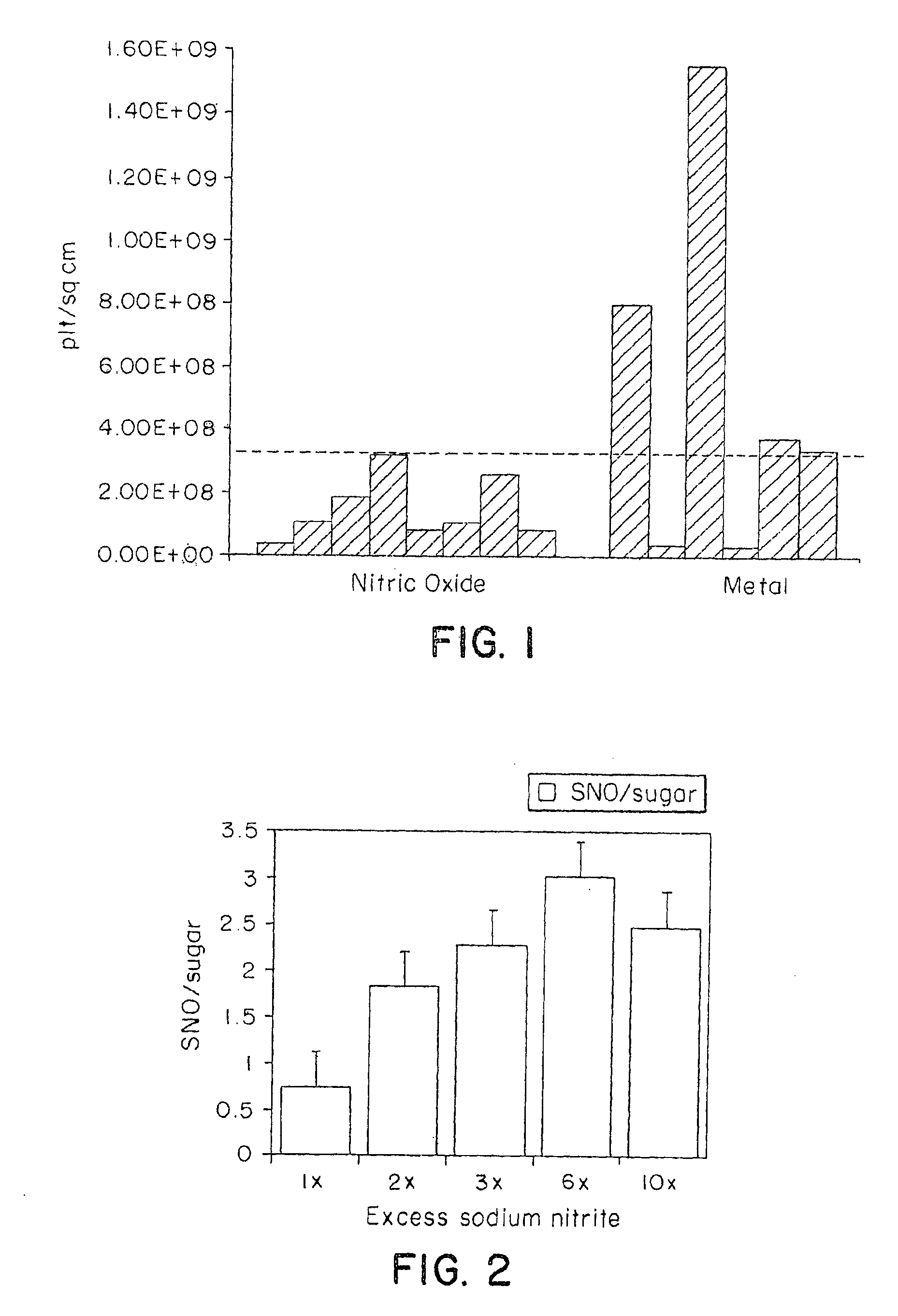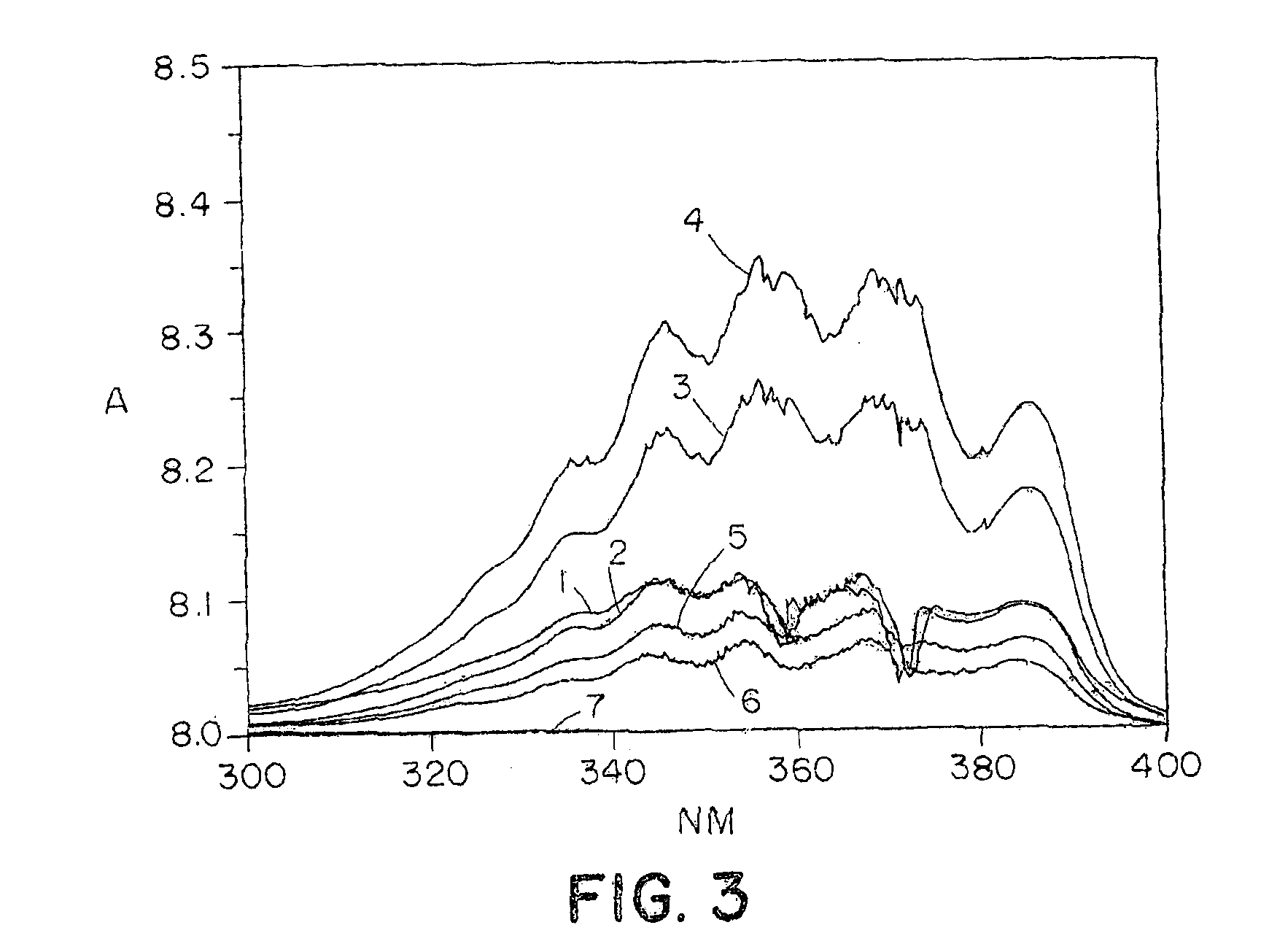Polymers for delivering nitric oxide in vivo
a technology of nitric oxide and nitric oxide, which is applied in the field of nitric oxide polymer delivery in vivo, can solve the problems of potentially life-threatening thrombosis, occlusion or blockage of the lumen, and complications which can arise, so as to increase shelf stability, and reduce platelet deposition and restnosis
- Summary
- Abstract
- Description
- Claims
- Application Information
AI Technical Summary
Benefits of technology
Problems solved by technology
Method used
Image
Examples
example 1
Preparation of Per-(6-deoxy-6-iodo)-β-iodocyclodextrin
β-Cyclodextrin (20.0 g, 17.6 mmol, 123 mmol primary hydroxyl) was added to a stirred solution of triphenylphosphine (97.2 g, 371 mmol, 3 eq per primary hydroxyl) and iodine chips (93.5 g, 371 mmol, 3 eq per primary hydroxyl) in dimethylformamide (DMF) (400 mL); the mixture warmed on addition. The solution was placed in an oil bath at 80° C. for 20 hours, then permitted to cool to room temperature DMF (350 mL) was removed under reduced pressure to yield a thick, the dark syrup was roughly one-third the volume of the original solution. To this syrup, cooled in an ice bath, was added 160 mL of 3 M NaOMe; the pH was found to be 9 (pH paper with a drop of water). After addition, the syrup was permitted to warm to room temperature and stirred for an additional 1 hour. The syrup was then poured into MeOH (3600 mL) to give a small amount of precipitate. Water (1000 mL) was added slowly to the MeOH solution, yielding a milky white precipi...
example 2
Preparation of Per-(6-deoxy-6-thio)β-thiocyclodextrin
Per-(6-deoxy-6-iodo)-β-cyclodextrin (19.84 g, 10.4 mmol, 72.9 mmol primary iodide) was dissolved in DMF (210 mL) and thiourea (6.3 g, 82.8 mmol, 1.13 eq) was added. The solution was stirred at 70° C. under nitrogen for 48 hours. DMF was removed under reduced pressure to give an orange oil, which was added to aqueous NaOH (5.4 g in 1000 mL, 135 mmol) to give a white precipitate on stirring. The solution was heated to a gentle reflux for 1 hour, which effected full solvation of the precipitate, then cooled, which resulted in formation of a precipitate that was removed by filtration and washed with water (this precipitate was not used). The solution was acidified with 1 M KHSO4 to give a fine white precipitate that was filtered and washed with water, then air-dried overnight. The precipitate was suspended in water (700 mL), then solvated by addition of 70 mL of aqueous 1 M NaOH, then re-precipitated with 90 mL of aqueous 1 M KHSO4. T...
example 3
Nitrosylation of Per-6-thio-β-cyclodextrin with Acidic Nitrite
Per-(6-deoxy-6-thio)-β-cyclodextrin (500 mg, 0.401 mmol, 2.81 mmol primary thiol) was dissolved in 0.5 M aqueous NaOH (10 mL) to give a faintly yellow solution. A mixture of 2.8 mL 1 M aqueous NaNO2 (2.8 mmol, 1 equivalent per mole free thiol) and 2 M HCl (15 mL) was quickly added to give a brick-red precipitate. The precipitate was pelleted by centrifuge, and the acidic supernatant was removed by syringe. Deionized water was added and the precipitate was agitated to full dispersion. The centrifugation / supernatant removal process was repeated six times (until the supernatant was neutral to pH paper), giving a deep red pellet in a small amount of water.
PUM
| Property | Measurement | Unit |
|---|---|---|
| Atomic mass | aaaaa | aaaaa |
| Atomic mass | aaaaa | aaaaa |
| Atomic mass | aaaaa | aaaaa |
Abstract
Description
Claims
Application Information
 Login to View More
Login to View More - R&D
- Intellectual Property
- Life Sciences
- Materials
- Tech Scout
- Unparalleled Data Quality
- Higher Quality Content
- 60% Fewer Hallucinations
Browse by: Latest US Patents, China's latest patents, Technical Efficacy Thesaurus, Application Domain, Technology Topic, Popular Technical Reports.
© 2025 PatSnap. All rights reserved.Legal|Privacy policy|Modern Slavery Act Transparency Statement|Sitemap|About US| Contact US: help@patsnap.com



